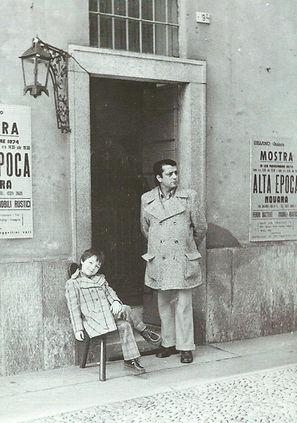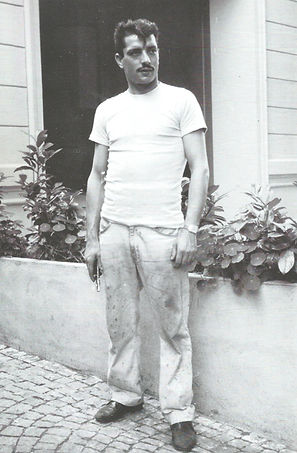
History










Urbano Quinto was born on Christmas Eve of 1933 in Rhodes Aegean - Greece,
at the time an Italian colony, descended from his father Luigi from a noble family, present in the annals since 1574. Quinto's father worked on the island as an official of AASS, a company prior to today's ANAS, building the roads and also contributing to the construction of the Kallithea Baths. The mother Barbara was instead from the same patrician branch by the explorer Umberto Nobile. At the end of the Second World War the family was repatriated and forced to abandon all properties. Before coming to fine and applied arts he carried out numerous works, like the appearance in the '40s and ‘50s Neorealism movies including the multiple Academy Award winners directed by Vittorio De Sica, Ladri di Biciclette and Sciuscià, and Mythological Peplum films at Cinecittà in Rome.
Urbano Quinto began to cultivate the cult of art and antiques in the early ‘60s in Lugano - Switzerland, working in well-known jewelery shop specializing in Lalique creations. The Switzerland is also decisive for his private life. It is there that he met Anita Bischoff in a restaurant in 1964, originally from Scuol - Schuls, in the Canton of Grisons, who became his wife in 1970. Anita is one of the five daughters of master blacksmith Gisep and Ludovica Roner. The wife Anita was a true source of inspiration for Quinto; a muse of the arts who substantially contributed to Urbano Quinto's escalation in the world of art, by picking up the baton relay at his death, by dedicating herself to writing, aimed at divulging the artistic erudition learned in her life, and the memory of his emblematic husband.
In 1964, in Novara - Italy, he began the activity of antique dealer, first as a freelancer and then with the opening of a small shop.
In 1973 he inaugurates in Novara the Urbano Quinto Gallery where in 1974 he will create Alta Epoca, one of the first exhibitions in Europe dedicated to wrought iron, metalworks and wooden artifacts of the haute époque.
Recognized as one of the most important European merchants specialized in the arts of the Middle Ages and the Renaissance, as well as being an excellent private collector, he has also dedicated himself to the study and is known throughout the world for his publications on the ancient arts of forged iron works. He had only one son, Mauro, born in 1968 in Mendrisio - Switzerland, so called in memory of his stage name used by him who in his youth did not like to be called Quinto.
The Urbano Quinto Collection includes famous masterpieces such as the iron flask damascening in gold and silver and the Chimeras key from the coffer secrets, works of the Renaissance by the extraordinary hand of Benvenuto Cellini. Significant masterpieces are also the Renaissance bronze plaque in dark patina, cast with lost wax and cold retouched with chisel, depicting The Last Supper from Leonardo da Vinci's workshop, the monumental pair of bronze fireplace andirons by the Alessandro Vittoria's workshop, the embossed and chiselled copper parade shield wheel, preserved in a leather patina, work of a craftsman near Michelangelo's workshop and the Donatellian boxwood Christ, extraordinarily executed without a loincloth in Florence, in the second half of the 15th century.
Another chapter of his life is that of his New York period where, introduced by Vidal Sassoon, he participated in 1977 in the inauguration of Studio 54 where through Bianca Jagger met Andy Warhol and starting to frequent the Factory, where he also became friend of Jean-Michel Basquiat and Keith Haring.
Andy Warhol portrayed and photographed him and his family several times with his famous Polaroids and Jean-Michel Basquiat portrayed him, together with his wife Anita and is son Mauro, in the series of works, initially created to be pasted onto canvas, "Swiss Lady, Swiss Boy and Urb". Keith Haring between 1982 and 1984 has several times amicably paid homage to Quinto, Anita and Mauro by depicting them during his impromptu performances in some of his famous drawings in the empty paper advertising spaces in the New York Subway. My American Period (1977 - 1987), so called by Urbano Quinto, by his express wish remained hidden for more than 20 years after his passing. His escalation into the Olympus of antiques had been so difficult, since he was a self-made man, that he didn't want his passion for Pop Art and these friendships could overshadow his international fame. In fact, in the 70s and 80s these artists certainly didn't have the consideration, especially in Italy, that they have now. A certain caste of antique dealers and experts considered, not understanding it, this form of art as controversial, unacceptable, miserably serial and branded its creators, snubbing them, as mere frivolous eccentrics snake oil salesmen. During his stays in the Big Apple he also met, introduced by Andy Warhol, John Lennon and David Bowie, with whom he shares his love for art and music.
In 1989, Urbano Quinto cemented his love for the seventh art by collaborating on the international television drama The Betrothed - I Promessi Sposi, directed by Salvatore Nocita and featuring music by Ennio Morricone. RAI - Radio Televisione Italiana (Italian National Television) availed itself of his consultancy for the creation of the suggestive scenography on the sets, featuring original period furnishings and objects, many of which were provided from the Urbano Quinto Gallery and from the Urbano Bischoff Private Collection of Art.
Urbano Quinto and Anita Bischoff were two great Amphitryons. In their house you could find unexpected guests such as Pablo Picasso, Salvador Dalì, Herbert von Karajan, Edita Gruberova, Emanuel Ungaro, Andy Warhol, Keith Haring or Jean-Michel Basquiat.
Urbano Quinto he left his human remains in Novara - Italy - on July 30, 1997.